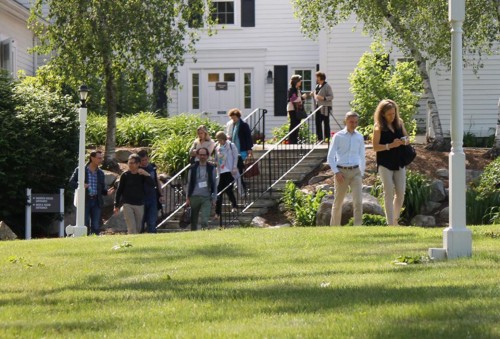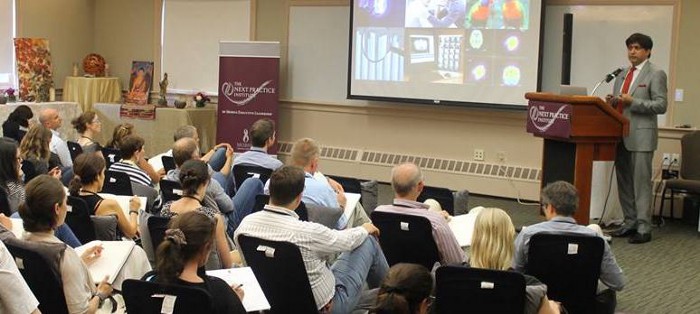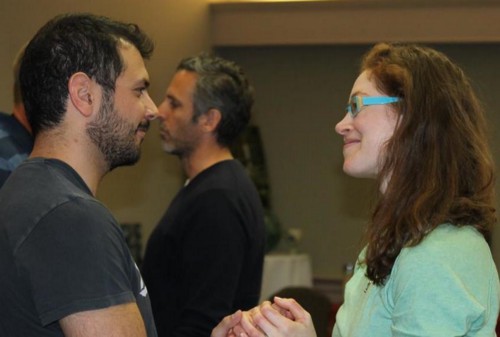How getting in bed with curiosity rocked my world
I’m a pretty strait-laced guy. Engineering degree. Logical thinker. Pragmatist. Etc. Etc.
And yet there I was in a room full of strangers. A wood fire crackling away. Candles lit. And my hands planted firmly on the shoulders of a guy I’d met 2 minutes earlier. We were welcoming each other with a quick massage as a sign of appreciation for each others’ gifts.
This may sound like a kinky late night movie. Instead, it was the beginning of an experiment. For five days I was replacing judgment with curiosity. Could I discover new ways to help my clients?
In my role as coach and consultant to CEOs, I do my best to move beyond best practice and into next practice. A trusted friend invited me to an east coast retreat with the Next Practice Institute. Not giving it too much thought, I signed up.
As the event approached, I explored the agenda in more detail. A realization set in. I was about to be pushed beyond my comfort zone.

The retreat wrapped up two weeks ago. Besides powerful keynotes and workshops, I experienced chanting, dancing, attunement, meditation, and mystical conversations. Before you conclude that I was at a hippie revival, let me add a few details about the speakers and participants. There were best-selling authors. Respected professors from MIT, Harvard, and Georgetown University. Top consultants from McKinsey. Executive search professionals from Egon Zehnder. Leaders of major international corporations. A top medical doctor.
By the end of the week, I realized I was in the midst of brilliance. And that I still have a lot to learn about being fully human.

I invite you to set aside all judgment and join me in curiosity for a few minutes. Here are four take-aways I am pondering after the retreat.
Mind to Mind: The concept of synchrony
According to Dr. Srini Pillay, “synchrony is a neural process where the frequency and scale of brain waves of people become in sync.” In a nutshell, this means two or more people are in agreement when their brain waves align.
…two or more people are in agreement when their brain waves align.
A Recent study found a link between leadership success and neural synchronization between the leader and followers. It turns out that the quality of communication (rather than the frequency) is key to a strong connection.

It seems that a leader’s understanding of synchrony is important to business success. We can more quickly reach mutual understanding. Cooperation, coordination of tasks, and collective team creativity increase.
Connecting heart and mind to boost performance
There is a general understanding that cognition (thinking) and emotion (feeling) are distinct. Control of each comes from separate and interconnecting neural systems within our body.
A recent study explored how these work together. The author explains, “when there is coherence within and between the mental and emotional systems, they interact constructively to expand awareness and permit optimal psychological and physiological functioning. Conversely, when the mental and emotional systems are out-of-phase, they lack synchronization and thus interact in a conflicting manner, thereby compromising performance.” That’s a long sentence to say that we can boost performance by aligning our minds and our hearts.
…we can boost performance by aligning our minds and our hearts.
So if we want to be in a top performance state, how do we get to be “in coherence”?
Alexander Caillet is an organizational psychologist known internationally for his pioneering approach to team coaching. In a recent HBR article, Alex and his co-authors explained the basics of reaching coherence. “Breathing can help you achieve a physiological condition called coherence, which leads to improved mental clarity, focus, emotional stability, and decision making. During coherence, the sympathetic (speeding up) and parasympathetic (slowing down) branches of the autonomic nervous system are working in reciprocity. When this happens our heart rate follows the same pattern — it speeds up and then slows down. Slower, deeper breathing at a constant rate can help induce coherence because when we inhale, our heart rate increases and when we exhale it decreases, thereby helping our nervous system achieve this balance.” The article goes on to share a second component to reaching coherence: activating positive feelings.
The power of love in business
Love is a word rarely heard within the business world. Robert Gass has worked with major corporations and governments to facilitate major transformation initiatives. In his words, “Love is the compassionate acceptance of others.” And, “is an intrinsically healing force.” When leaders start from a place of love, “transformative interactions can occur without triggering defensiveness.”

This concept played out in an important study completed by Google. Over a two year period Google conducted over 200 interviews with its employees. They looked at more than 250 attributes of over 180 active Google teams. The study found that psychological safety is the number one determinant of high performance in teams. Harvard professor Amy Edmondson defines psychological safety as a ‘‘shared belief held by members of a team that the team is safe for interpersonal risk-taking.’’ In other words, when people feel that their team is built on a foundation of love, the team performs better.
…when people feel that their team is built on a foundation of love, the team performs better.
Rebalancing mind and body

What role does the body have in business and leadership? Somatics aims to answer this question. Somatics is the field of body awareness, bodywork and movement studies. It emphasizes our internal physical perceptions and experiences. Jen Cohen is a pioneering practitioner in the space. In her words, “The Scientific Revolution was a moment of the splitting of body and mind and spirit. Mind was elevated. Body subjugated. Spirit disengaged.”
Somatics aims to reconnect the body with mind and spirit so that we are operating with the ultimate trifecta.
…reconnect the body with mind and spirit so that we are operating with the ultimate trifecta.
An example is the personal or organizational struggle with change. Why do we slip back to our old ways? According to Jen Cohen, “Cells go for equilibrium and stability. That’s just what they do. That said, the capacity to stay with dis-equilibrium can be trained… and that’s a critical competency.” Basically, our body keeps bringing us back.
To sign up for next year’s Next Practice Institute, visit Mobius Leadership.
Are you a founding CEO? If you want to incorporate these concepts into your personal performance, visit www.brentlowe.com.Mission.or
An example is the personal or organizational struggle with change. Why do we slip back to our old ways? According to Jen Cohen, “Cells go for equilibrium and stability. That’s just what they do. That said, the capacity to stay with dis-equilibrium can be trained… and that’s a critical competency.” Basically, our body keeps bringing us back.
To sign up for next year’s Next Practice Institute, visit Mobius Leadership.
I blog to help Founder CEOs on their journey from kitchen table to 200 employees. Be the first to receive new articles by signing up for my newsletter here.
